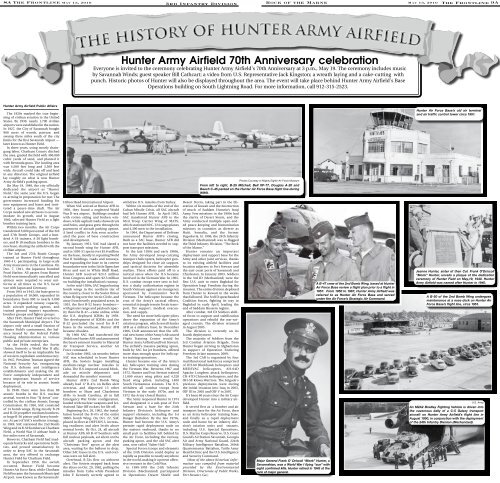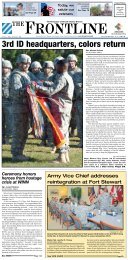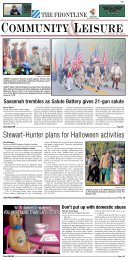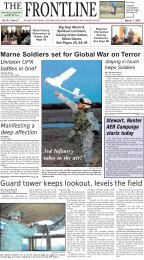3rd Infantry Division The Frontline May 13, 2010 - Fort Stewart ...
3rd Infantry Division The Frontline May 13, 2010 - Fort Stewart ...
3rd Infantry Division The Frontline May 13, 2010 - Fort Stewart ...
You also want an ePaper? Increase the reach of your titles
YUMPU automatically turns print PDFs into web optimized ePapers that Google loves.
8A <strong>May</strong> <strong>13</strong>, <strong>2010</strong><br />
<strong>The</strong> <strong>Frontline</strong> <strong>May</strong> <strong>13</strong>, <strong>2010</strong><br />
Hunter Army Airfield Public Affairs<br />
<strong>The</strong> 1920s marked the true beginning<br />
of civilian aviation in the United<br />
States. By 1930, nearly 1,700 civilian<br />
airports were established in the nation.<br />
In 1927, the City of Savannah bought<br />
900 acres of woods, pasture, and<br />
swamp three miles south of the city<br />
limits for the first Savannah Airport —<br />
later known as Hunter Field.<br />
In three years, using mostly chaingang<br />
labor, Chatham County ditched<br />
the area, graded the field with 400,000<br />
cubic yards of sand, and planted it<br />
with Bermuda grass. <strong>The</strong> landing area<br />
was 4,500 feet long and 3,500 feet<br />
wide. Aircraft could take off and land<br />
in any direction. <strong>The</strong> original airfield<br />
lay roughly on what is now Hunter<br />
Army Airfield’s parking apron.<br />
On <strong>May</strong> 19, 1940, the city officially<br />
dedicated the airport as “Hunter<br />
Field,” the same year the U.S. began<br />
re-arming in preparation for war. <strong>The</strong><br />
government increased funding for<br />
new equipment and bases and instituted<br />
a peace-time draft. <strong>The</strong> Air<br />
Corps needed new airbases to accommodate<br />
its growth, and in August<br />
1940, selected Hunter Field as a light<br />
bomber training base.<br />
Within two months, the Air Corps<br />
transferred 3,000 personnel of the <strong>3rd</strong><br />
and 27th Bomb Groups, and a hundred<br />
A-18 trainers, A-20 light bombers,<br />
and B-18 medium bombers to the<br />
new base, sharing the airfield with the<br />
civilian airport.<br />
<strong>The</strong> <strong>3rd</strong> and 27th Bomb Groups<br />
trained at Hunter Field throughout<br />
1940-41, participating in large-scale<br />
Army maneuvers in the Carolinas. On<br />
Dec. 7, 1941, the Japanese bombed<br />
Pearl Harbor. All passes from Hunter<br />
Field were immediately cancelled and<br />
airmen were required to wear uniforms<br />
at all times as the U.S. faced<br />
war with Japan and Germany.<br />
From 1941 to 1943, the base grew to<br />
a population of 10,000, expanded its<br />
boundaries from 900 to nearly 3,000<br />
acres. It expanded runway capacity,<br />
built aircraft parking aprons, and<br />
trained ground support squadrons,<br />
bomber groups and fighter groups.<br />
After 1945, Hunter Field reverted to<br />
the Savannah Municipal Airport. <strong>The</strong><br />
airport only used a small fraction of<br />
Hunter Field’s cantonment, the balance<br />
leased by the Federal Public<br />
Housing Administration to various<br />
public and private enterprises.<br />
As the 1940s ended, the Soviet<br />
Union, formerly a World War II ally,<br />
showed itself to be an implacable foe<br />
of western capitalism and democracy.<br />
In 1947, President Truman signed the<br />
National Security Act, reorganizing<br />
the U.S. defense and intelligence<br />
establishments and making the Air<br />
Force completely independent and<br />
most important branch of service<br />
because of its role in atomic bomb<br />
deployment.<br />
In 1948, there were less than 60<br />
atomic bombs in the U.S. nuclear<br />
arsenal, stored in four “Q Areas” controlled<br />
by the civilian Atomic Energy<br />
Commission. By 1950, SAC consisted<br />
of 14 bomb wings, flying mostly B-29<br />
and B-50 propeller medium bombers,<br />
or huge B-36 piston-pull heavy bombers.<br />
As part of SAC’s southern strategy,<br />
in 1949, SAC stationed the 2nd Bomb<br />
Wing and its B-50 bombers at Chatham<br />
Field, a World War II airbase built a<br />
few miles west of Savannah.<br />
However, Chatham Field had inadequate<br />
barracks and operations facilities,<br />
and proved unsatisfactory. In<br />
order to keep SAC in the Savannah<br />
area, the city offered to exchange<br />
Hunter Field for Chatham Field.<br />
In September 1950, the switch<br />
occurred. Hunter Field became<br />
Hunter Air Force Base, while Chatham<br />
Field became the Savannah Municipal<br />
Airport, now known as the Savannah/<br />
Hilton Head International Airport.<br />
When SAC arrived at Hunter AFB in<br />
1950, they found a neglected World<br />
War II-era airport. Buildings creaked<br />
with rotten siding and broken windows,<br />
while asphalt roads showed ruts<br />
and holes, and grass grew through the<br />
pavement of aircraft parking aprons.<br />
A land conflict in Asia soon accelerated<br />
the pace of base construction<br />
and development.<br />
By January 1951, SAC had slated a<br />
second bomb wing for Hunter AFB,<br />
and in 1950-51 spent over $5.6 million<br />
on the base, mostly in repairing World<br />
War II buildings, roads and runways,<br />
and expanding the base to its current<br />
boundaries west to the Little Ogeechee<br />
River and east to White Bluff Road.<br />
Hunter AFB received $24.5 million<br />
from Congress and spent $2.5 million<br />
on building the installation’s runway.<br />
In the mid-1950s, SAC began basing<br />
bomb wings in the northern tier of<br />
the country, closer to the Soviet Union<br />
when flying over the Arctic Circle, and<br />
away from heavily populated areas. In<br />
1955, the first B-52 heavy bombers—<br />
with greater range and payload capacity<br />
than the B-47—came online, while<br />
the U.S. deployed ICBMs by 1959.<br />
<strong>The</strong> development of ICBMs and the<br />
B-52 precluded the need for B-47<br />
bases in the southeast. Hunter AFB<br />
became obsolete.<br />
By 1960 SAC had transferred the<br />
30th from Hunter AFB and announced<br />
the base’s eminent transfer to Material<br />
Air Transport Service, another Air<br />
Force command.<br />
In October 1962, six months before<br />
SAC was scheduled to leave Hunter<br />
AFB, the Soviets began installing<br />
medium-range nuclear missiles in<br />
Cuba. <strong>The</strong> U.S. imposed a naval blockade<br />
on missile shipments and<br />
demanded the missiles’ removal.<br />
Hunter AFB’s 2nd Bomb Wing<br />
already had 17 B-47s on Reflex alert<br />
overseas, and dispersed <strong>13</strong> other<br />
bombers to Shaw and Charleston<br />
AFBs in South Carolina, all in full<br />
Emergency War Order configuration,<br />
loaded with nuclear weapons and Jet-<br />
Assisted Take Off rockets for lift-off.<br />
Beginning Oct. 20, 1962, the installation<br />
hosted the B-47s of the entire<br />
306th bomb Wing. On Oct. 22, SAC<br />
placed its fleet at DEFCON 3, increasing<br />
readiness and alert levels above<br />
normal levels. By Oct. 24, all aircraft<br />
at Hunter AFB, 60 B-47 bombers with<br />
full nuclear payloads, sat silent on the<br />
aircraft parking apron and the<br />
“Christmas Tree” apron at the alert<br />
area, waiting for the balloon to drop.<br />
Other SAC bases in the U.S. and overseas<br />
were on full alert.<br />
Overhead, B-52s flew on airborne<br />
alert. <strong>The</strong> Soviets stepped back from<br />
the abyss on Oct. 29, 1962, pulling the<br />
missiles from Cuba while President<br />
John F. Kennedy secretly agreed to<br />
withdraw U.S. missiles from Turkey.<br />
Within six months of the end of the<br />
Cuban Missile Crisis, all SAC aircraft<br />
had left Hunter AFB. In April 1963,<br />
SAC transferred Hunter AFB to the<br />
6<strong>3rd</strong> Troop Carrier Wing of MATS,<br />
which stationed 60 C-124 cargo planes<br />
and 4,300 men to the installation.<br />
In 1964, the Department of Defense<br />
announced Hunter AFB’s closing.<br />
Built as a SAC base, Hunter AFB did<br />
not have the facilities needed to support<br />
transport missions.<br />
In the late 1950s and early 1960s,<br />
the Army developed troop-carrying<br />
transport helicopters, helicopter gunships<br />
designed for close air support,<br />
and tactical doctrine for airmobile<br />
warfare. <strong>The</strong>se efforts paid off in a<br />
tactical sense when the U.S became<br />
involved in the Vietnam War. In 1965,<br />
U.S. combat troops were sent to bolster<br />
a shaky authoritarian regime in<br />
South Vietnam against an insurgency<br />
sponsored by Communist North<br />
Vietnam. <strong>The</strong> helicopter became the<br />
crux of the Army’s tactical efforts,<br />
essential in jungle terrain for air transport,<br />
fire support, medical evacuation,<br />
and supply.<br />
<strong>The</strong> need for more helicopter pilots<br />
drove the expansion of the Army’s<br />
aviation program, which saved Hunter<br />
AFB as a military base. In December<br />
1966, DoD announced that the official<br />
new home of the Army’s Advanced<br />
Flight Training Center would be<br />
Hunter Army Airfield and <strong>Fort</strong> <strong>Stewart</strong>.<br />
<strong>The</strong> airfield’s massive parking apron,<br />
built by SAC for jet bombers, offered<br />
more than enough space for helicopter<br />
training operations.<br />
Hunter became one of the Army’s<br />
key helicopter training sites during<br />
the Vietnam War. Between 1967 and<br />
1972, Hunter and <strong>Fort</strong> <strong>Stewart</strong> trained<br />
11,000 rotary wing pilots and 4,328<br />
fixed wing pilots, including 1400<br />
South Vietnamese aviators. <strong>The</strong> U.S.<br />
withdrew all combat troops from<br />
Vietnam in the early 1970s, and in<br />
1972 the Army closed Hunter.<br />
<strong>The</strong> Army reopened Hunter in 1974<br />
and designated it a sub-post of <strong>Fort</strong><br />
<strong>Stewart</strong> and a base for the 24th<br />
<strong>Infantry</strong> <strong>Division</strong>’s helicopter and<br />
support elements, including the 1st<br />
Ranger Battalion. By the late 1970s,<br />
Hunter had become the U.S. Army’s<br />
premier rapid deployment node on<br />
the eastern seaboard, thanks in no<br />
small part to facilities left behind by<br />
the Air Force, including the runway,<br />
parking apron, and the old SAC alert<br />
area, now called “Saber Hall.”<br />
Special Forces troops and elements<br />
of the 24th <strong>Division</strong> could deploy as<br />
rapidly as possible to nearly anywhere<br />
in the world, making it a potent offensive<br />
resource in the Cold War.<br />
In 1990-1991 the 24th <strong>Infantry</strong><br />
<strong>Division</strong> (Mechanized) participated<br />
in Operations Desert Shield and<br />
<strong>3rd</strong> <strong>Infantry</strong> <strong>Division</strong><br />
Desert Storm, taking part in the liberation<br />
of Kuwait and the destruction<br />
of much of Saddam Hussein’s Iraqi<br />
Army. Few missions in the 1990s had<br />
the clarity of Desert Storm, and the<br />
Army conducted multiple open-ended<br />
peace-keeping and humanitarian<br />
missions in countries as diverse as<br />
Haiti, Somalia, and the former<br />
Yugoslavia. In 1996, the 24th <strong>Infantry</strong><br />
<strong>Division</strong> (Mechanized) was re-flagged<br />
the Third <strong>Infantry</strong> <strong>Division</strong>, “<strong>The</strong> Rock<br />
of the Marne.”<br />
Hunter remains an important<br />
deployment and support base for the<br />
Army and other joint services, thanks<br />
to its existing airfield facilities and<br />
location adjacent to <strong>Fort</strong> <strong>Stewart</strong> and<br />
the east coast ports of Savannah and<br />
Charleston. In January 2003, Soldiers<br />
in the <strong>3rd</strong> ID (Mechanized) were the<br />
first U.S. unit to enter Baghdad for<br />
Operation Iraqi Freedom during the<br />
invasion. <strong>The</strong> entire division deployed<br />
from Hunter to Kuwait in the weeks<br />
that followed. <strong>The</strong> <strong>3rd</strong> ID spearheaded<br />
Coalition forces, fighting its way to<br />
Baghdad in early April, leading the<br />
end of Saddam Hussein regime.<br />
After combat, <strong>3rd</strong> ID Soldiers shifted<br />
focus to support and stabilization<br />
operations and rebuild the war-ravaged<br />
country. <strong>The</strong> division returned<br />
in August 2003.<br />
<strong>The</strong> division is currently on its<br />
fourth deployment.<br />
<strong>The</strong> majority of Soldiers from the<br />
<strong>3rd</strong> Combat Aviation Brigade, from<br />
Hunter began arriving in Afghanistan<br />
in support of Operation Enduring<br />
Freedom in late summer, 2009.<br />
<strong>The</strong> <strong>3rd</strong> CAB is organized by four<br />
multifunctional task forces comprised<br />
of UH-60 Blackhawk helicopters and<br />
MEDEVAC helicopters, AH-64D<br />
Apache Longbow attack helicopters,<br />
CH-47D Chinook helicopters, and the<br />
OH-58 Kiowa Warriors. <strong>The</strong> brigade's<br />
previous deployments were during<br />
the initial invasion into Iraq in 2003,<br />
OIF III in 2005 and OIF V in 2007.<br />
It’s been 60 years since the Air Corps<br />
developed Hunter into a military airfield.<br />
It served first as a bomber and air<br />
transport base for the Air Force, then<br />
as an Army helicopter training base,<br />
and finally as a rapid deployment<br />
node and home for an infantry division’s<br />
aviation units and tenants,<br />
including U.S. Special Operations,<br />
U.S. Marine Corps Reserve, U.S. Coast<br />
Guard’s Air Station Savannah, Georgia<br />
Air and Army National Guard, 224th<br />
Military Intelligence Battalion, 260th<br />
Quartermaster Battalion, Tuttle Army<br />
Health Clinic and the U.S. Intelligence<br />
and Security Command.<br />
(Most of the above historical information<br />
was compiled from material<br />
provided by the Environmental<br />
<strong>Division</strong>, Directorate of Public Works,<br />
<strong>Fort</strong> <strong>Stewart</strong>, Ga.)<br />
Rock of the Marne <strong>The</strong> <strong>Frontline</strong> 9A<br />
Hunter Army Airfield 70th Anniversary celebration<br />
Everyone is invited to the ceremony celebrating Hunter Army Airfield's 70th Anniversary at 3 p.m., <strong>May</strong> 19. <strong>The</strong> ceremony includes music<br />
by Savannah Winds; guest speaker Bill Cathcart; a video from U.S. Representative Jack Kingston; a wreath laying and a cake-cutting with<br />
punch. Historic photos of Hunter will also be displayed throughout the area. <strong>The</strong> event will take place behind Hunter Army Airfield's Base<br />
Operations building on South Lightning Road. For more information, call 912-315-2523.<br />
Photos Courtesy of Mighty Eighth Air Force Museum<br />
From left to right, B-25 Mitchell, Bell XP-77, Douglas A-20 and<br />
Beech C-45 parked on the Hunter Air Force Base flight line during<br />
WWII.<br />
Major General Frank O’ Driscoll “Monk” Hunter, a<br />
Savannahian, was a World War I flying “ace” with<br />
eight confirmed kills. Hunter retired in 1945 at the<br />
rank of major general.<br />
A B-47 crew of the 2nd Bomb Wing, based at Hunter<br />
Air Force Base review a flight plan prior to a flight in<br />
1957. From 1950 to 1967, Hunter Army Airfield was<br />
referred to as Hunter Air Force Base and served<br />
under the Air Force’s Strategic Air Command.<br />
Hunter Air Force Base’s old air terminal<br />
and air traffic control tower circa 1951.<br />
Jeanne Hunter, sister of then Col. Frank O’Driscoll<br />
"Monk" Hunter, unveils a plaque at the dedication<br />
ceremony of Hunter Field on <strong>May</strong>,19, 1940. Hunter<br />
Army Airfield was named after Hunter in 1940.<br />
A B-50 of the 2nd Bomb Wing undergoes<br />
maintenance at a nose dock on Hunter Air<br />
Force Base’s flight line, circa 1951.<br />
U.S. Army<br />
An M2A2 Bradley Fighting Vehicle is driven into<br />
the cavernous belly of a C-5 Galaxy transport<br />
aircraft on Hunter Army Airfield’s flight line in<br />
August 1990, in conjunction with the deployment<br />
of the 24th <strong>Infantry</strong> <strong>Division</strong> (Mechanized).

















